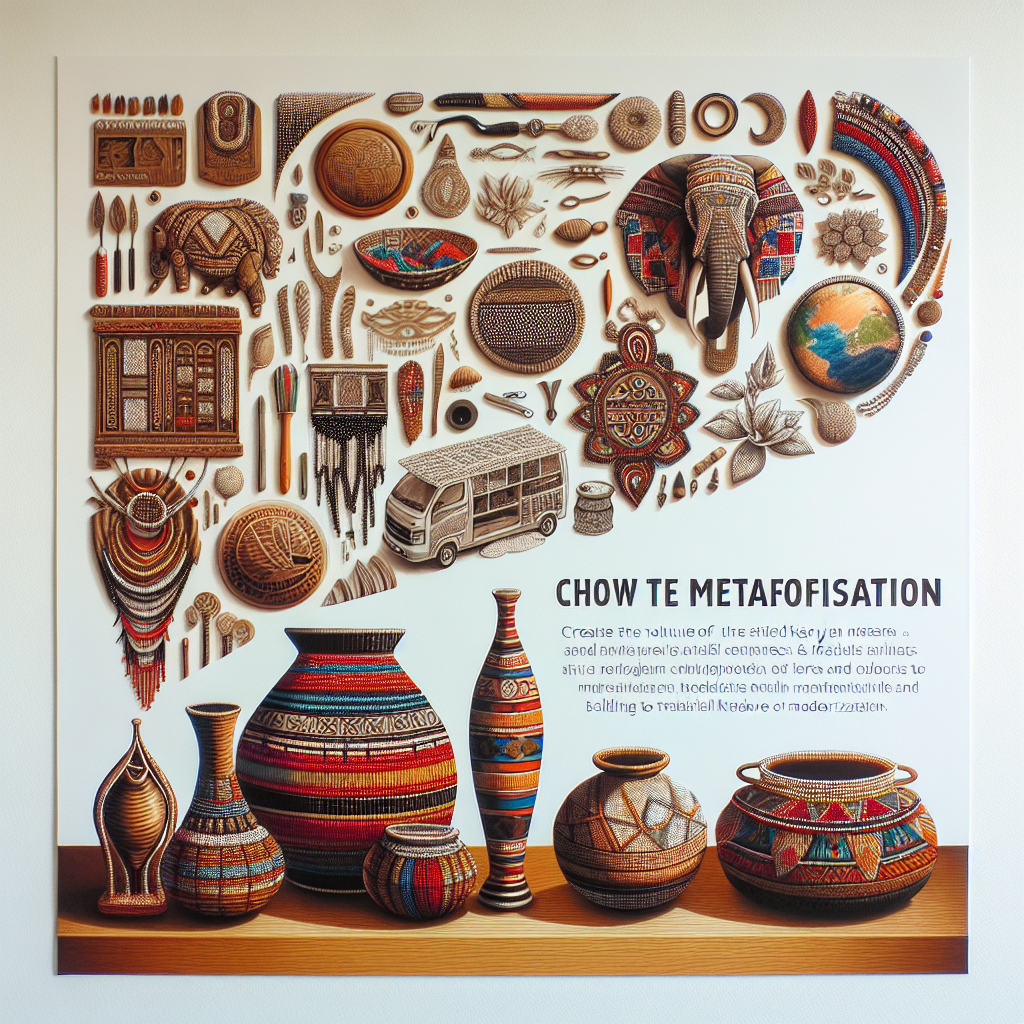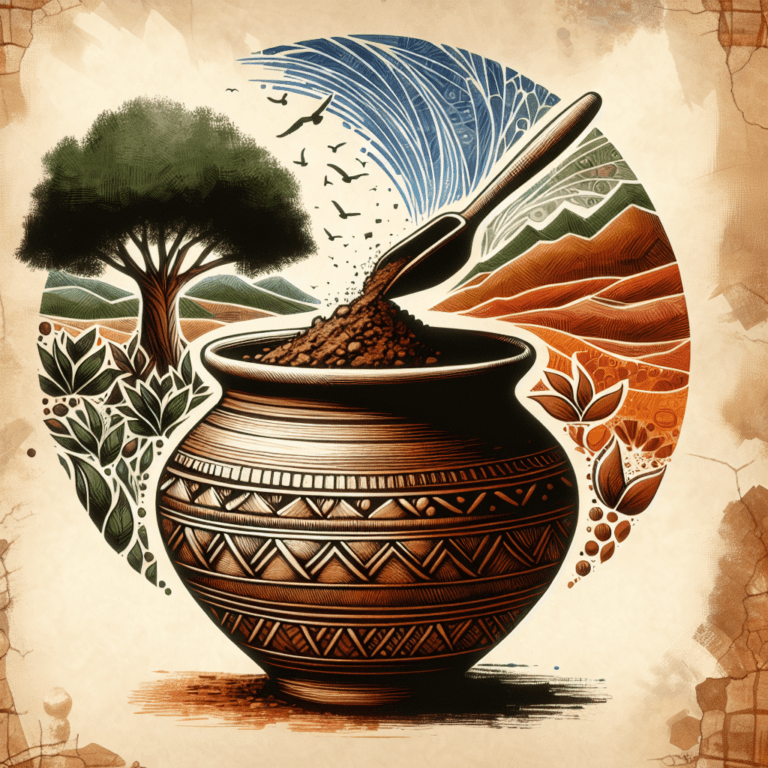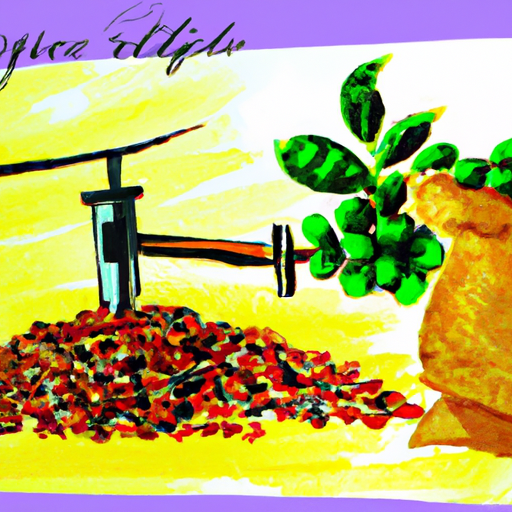How Have Traditional Kenyan Art And Crafts Evolved Over Time?
In this article, you’ll explore the fascinating evolution of traditional Kenyan art and crafts throughout the years. Discover how the artistic expressions of Kenya have transformed, reflecting its rich cultural heritage and the influences of modernization. From intricate beadwork and wooden carvings to vibrant textiles and pottery, uncover the unique stories and techniques that have shaped traditional Kenyan art into what it is today. Embark on a journey through time as we delve into the captivating transformation of this vibrant artistic tradition.
Influence of Traditional African Cultures
Traditional African cultures have played a significant role in shaping the art and crafts of Kenya. The impact of tribal traditions on Kenyan art cannot be understated, as each tribe has its own unique artistic expressions. These tribal traditions have been passed down through generations, with oral history playing a crucial role in preserving and shaping traditional art.
Impact of tribal traditions on Kenyan art and crafts
Kenya is home to numerous tribes, each with its own distinct artistic traditions. The art and crafts produced by these tribes are a reflection of their beliefs, cultural practices, and way of life. For example, the Maasai tribe is renowned for their intricate beadwork, which not only serves as a form of personal adornment but also carries deep symbolic meaning. Similarly, the Kamba people are known for their skilled woodcarving, which showcases their connection to nature and their ancestral spirits.
Role of oral history in shaping traditional art
In traditional African cultures, oral history has been the primary means of passing down cultural knowledge from one generation to the next. Through storytelling and oral performances, the history, myths, and legends of each tribe are kept alive. This oral tradition has also influenced the artistic expressions of Kenyan tribes. Many traditional art forms, such as pottery, basket weaving, and textile designs, incorporate symbolic motifs and patterns that are derived from oral narratives. This interweaving of oral history and artistic expression creates a rich tapestry of cultural heritage in Kenyan art.
Symbolism in traditional Kenyan art and crafts
Symbolism plays a vital role in traditional Kenyan art and crafts, adding layers of meaning and significance to the artistic creations. Patterns, colors, and motifs used in various art forms often carry symbolic representations of social status, spirituality, and cultural identity. For example, the intricate geometric patterns seen in Maasai beadwork symbolize unity, while the use of specific animal motifs in woodcarvings represents the tribe’s connection to nature and their beliefs. By incorporating these symbols, Kenyan artists communicate cultural values and beliefs to both their own community and the wider world.
Encounter with Arab Traders
Kenya’s location along the eastern coast of Africa made it a significant trading hub in ancient times. The arrival of Arab traders brought new materials, techniques, and influences that enriched Kenyan art and crafts.
Introduction of new materials and techniques
Arab traders introduced new materials to Kenya, such as glass beads, dyes, and metals. These materials were incorporated into existing artistic practices, expanding the range of colors, textures, and designs. Arab traders also brought with them new techniques, such as metalworking and intricate weaving patterns. These techniques were adopted and adapted by Kenyan artisans, leading to the development of new artistic styles and forms.
Arab influences on design and motifs
The interactions with Arab traders also influenced the design and motifs in Kenyan art and crafts. Arab geometric patterns and calligraphic designs found their way into Kenyan pottery, textiles, and architecture. The fusion of Arab and African artistic elements resulted in a unique blend of styles that is characteristic of Kenyan art. This cross-cultural exchange not only enriched Kenyan artistic traditions but also contributed to the multicultural identity of the country.
European Colonialism
The arrival of European colonizers in Kenya had a profound impact on its art and crafts. European art styles, a shift from utilitarian crafts to commercial production, and the influence of missionary schools all played a role in shaping the artistic landscape during this period.
Introduction of European art styles
European colonizers brought with them their own artistic traditions and styles, which heavily influenced the art scene in Kenya. European painting techniques, such as perspective and realistic portraiture, were introduced to Kenyan artists, leading to a departure from traditional styles. Western art subjects, such as landscapes and commissioned portraits, gained popularity among Kenyan artists who sought to adapt to the changing tastes of the colonial elite.
Shift from utilitarian crafts to commercial production
Under colonial rule, there was a shift from the production of crafts for personal and community use to the creation of crafts for commercial purposes. This change was driven by the demand for African artworks by European settlers and tourists. Traditional crafts, such as pottery, basket weaving, and woodcarving, were mass-produced for the market, leading to changes in materials, styles, and techniques. While this shift allowed Kenyan artisans to earn a livelihood, it also led to the dilution of traditional artistic practices.
Influence of missionary schools on artistic techniques
Missionary schools played a crucial role in shaping the artistic techniques and training of Kenyan artists during the colonial era. Missionaries introduced Western art education, including drawing, painting, and sculpture, to Kenyan students. These schools provided opportunities for talented individuals to develop their artistic skills and gain exposure to new artistic forms. The influence of missionary schools can still be seen in the techniques and styles employed by many Kenyan artists today.
Independence and Modernization
The period following Kenya’s independence brought about significant changes in the art and crafts scene. Urban art centers emerged, contemporary themes and materials were incorporated into traditional art, and there was innovation in art education and training.
Emergence of urban art centers
With the urbanization and modernization of Kenya, urban art centers began to flourish. Cities such as Nairobi became hubs for artistic expression, with galleries, studios, and art institutions providing platforms for artists to showcase their work. These urban art centers served as spaces for creativity, collaboration, and the exchange of ideas, leading to the growth and diversification of Kenyan art.
Incorporation of contemporary themes and materials
The post-independence era saw a significant shift in the themes and materials used in Kenyan art and crafts. Artists started to explore contemporary issues, such as social justice, political freedom, and gender equality, through their artistic creations. Traditional art forms, such as beadwork and woodcarving, were infused with modern materials and techniques, creating a fusion of tradition and innovation. This integration of contemporary themes and materials gave Kenyan art a fresh and relevant perspective.
Innovation in art education and training
The establishment of art schools and institutions in Kenya after independence led to advancements in art education and training. These institutions provided formal training in various artistic disciplines, such as painting, sculpture, and printmaking. Art students were exposed to both traditional and contemporary art practices, enabling them to explore their creativity and develop their own artistic styles. This emphasis on art education and training contributed to the professionalization of the art sector in Kenya.
Preservation and Revival Efforts
In recent years, there has been a growing recognition of the importance of preserving traditional Kenyan art and crafts. Efforts have been made to establish national museums and galleries, promote traditional art and crafts through festivals, and revive dying techniques and endangered crafts.
Establishment of national museums and galleries
National museums and galleries have played a crucial role in preserving and showcasing traditional Kenyan art and crafts. These institutions serve as custodians of cultural heritage, housing collections of artifacts and artworks that represent the diverse artistic traditions of the country. Through exhibitions and educational programs, museums and galleries promote an understanding and appreciation of traditional art among both Kenyans and international visitors.
Promotion of traditional art and crafts through festivals
Festivals dedicated to traditional art and crafts have become increasingly popular in Kenya. These festivals provide a platform for artisans to showcase their skills and creations, while also creating opportunities for cultural exchange and economic empowerment. Traditional art forms, such as drumming, dance, and beadwork, are celebrated during these festivals, reinforcing their significance and ensuring their continued practice and preservation.
Revival of dying techniques and endangered crafts
In an effort to revive dying techniques and endangered crafts, initiatives have been launched to train younger generations in traditional art forms. Master craftsmen and artisans pass on their knowledge and skills to apprentices, ensuring the continuity of these crafts. By reviving dying techniques, such as traditional pottery firing methods or intricate weaving patterns, Kenya is preserving its cultural heritage and promoting sustainable livelihoods for artisans.
Globalization and International Exposure
Kenyan art and crafts have seen a significant impact from globalization and international exposure. Tourism has influenced the traditional art market, collaborations with international artists and designers have brought new perspectives, and modern technology has been integrated into traditional crafts.
Impact of tourism on the traditional art market
The rise in tourism in Kenya has had a profound impact on the traditional art market. Tourists, both local and international, seek out authentic Kenyan art and crafts as souvenirs and decorative items. This demand has led to changes in the production, marketing, and pricing of traditional crafts. Artisans have adapted their artistic practices to cater to the tastes and preferences of tourists, resulting in a blending of traditional and contemporary elements in their creations.
Collaboration with international artists and designers
Collaborations between Kenyan artists and international artists and designers have brought new perspectives and ideas to the country’s art scene. These collaborations have led to the fusion of different artistic styles, techniques, and materials, resulting in innovative and unique artworks. The exchange of knowledge and experiences between local and international artists has created opportunities for mutual learning and growth, while also exposing Kenyan artists to global audiences.
Integration of modern technology into traditional crafts
Modern technology has been integrated into traditional Kenyan crafts, enabling artisans to enhance their production processes and reach new markets. For example, the use of computer-aided design (CAD) in beadwork and textile design has allowed for precise and intricate patterns to be created. Additionally, online platforms and social media have provided a global marketplace for Kenyan artisans, allowing them to showcase and sell their creations to a wider audience. The integration of modern technology has not only increased the efficiency and profitability of traditional crafts but has also opened up new possibilities for artistic expression.
Changing Role and Perception of Artisans
The role and perception of artisans in Kenyan society have evolved over time. From subsistence livelihoods to entrepreneurship, artisans have been recognized as cultural ambassadors, while women have gained empowerment in the art and crafts sector.
Transition from subsistence livelihoods to entrepreneurship
Traditionally, artisans engaged in their craft as a means of subsistence. However, with changing economic dynamics and the growth of the art market, many artisans have transitioned from subsistence livelihoods to entrepreneurship. They have started their own businesses, showcasing and selling their creations to a broader customer base. This shift has empowered artisans to control their own economic destinies and has contributed to the sustainability of traditional art and crafts.
Recognition of artisans as cultural ambassadors
Artisans in Kenya are increasingly being recognized as cultural ambassadors, representing the rich heritage and artistic traditions of the country. Their creations tell stories, preserve cultural knowledge, and contribute to the national identity. Kenyan artisans are often invited to participate in international exhibitions, cultural exchanges, and festivals, showcasing the diversity and beauty of their artistic heritage. This recognition not only provides opportunities for artisans to gain exposure and new markets but also contributes to the promotion and preservation of traditional art.
Empowerment of women in the art and crafts sector
The art and crafts sector in Kenya has provided opportunities for women to gain empowerment and economic independence. Traditionally, women played a significant role in crafting, particularly in areas such as weaving and beadwork. With the growth of the art market, women artisans have been able to build businesses, support their families, and engage in decision-making processes within their communities. The art and crafts sector has become a vehicle for women’s empowerment, allowing them to break traditional gender roles and redefine their roles in society.
The Influence of Contemporary Challenges
Contemporary challenges have shaped the art and crafts of Kenya, with a focus on environmental sustainability, the incorporation of social and political issues, and economic viability in a globalized market.
Environmental sustainability in art and crafts production
In recent years, there has been a growing emphasis on environmental sustainability in the production of art and crafts in Kenya. Artisans have started incorporating eco-friendly materials, such as recycled materials and natural dyes, into their creations. Additionally, there is a focus on sustainable practices, such as using renewable energy sources and minimizing waste. By prioritizing environmental sustainability, Kenyan artisans are ensuring the long-term viability of their crafts while also contributing to the global movement towards sustainable art practices.
Incorporation of social and political issues in artistic expression
Kenyan artists have increasingly used their creations to address social and political issues affecting their country and the African continent as a whole. Through their art, they bring attention to issues such as poverty, discrimination, gender inequality, and political corruption. Art has become a powerful tool for social commentary and activism, encouraging dialogue and raising awareness among the public. By incorporating social and political issues in their artistic expressions, Kenyan artists are contributing to societal change and advocating for a more inclusive and just society.
Economic viability in a globalized market
In a globalized market, economic viability is a crucial consideration for Kenyan artisans. They must adapt their artistic practices to meet the demands of the market and ensure a sustainable livelihood. This includes considerations such as pricing, quality control, and marketing strategies. Artisans are also exploring new opportunities for collaboration and diversification to remain competitive in the global market. By focusing on economic viability, Kenyan artisans can continue to preserve their artistic traditions while also creating sustainable economic opportunities for themselves and their communities.
Preserving Traditional Knowledge and Techniques
Preserving traditional knowledge and techniques is paramount to ensuring the continuity and authenticity of Kenyan art and crafts. Efforts are being made to facilitate intergenerational knowledge transfer, document and archive traditional practices, and address challenges in adapting traditional crafts to modern lifestyles.
Importance of intergenerational knowledge transfer
Intergenerational knowledge transfer is crucial for preserving traditional knowledge and techniques in Kenyan art and crafts. Master craftsmen and artisans pass on their skills, techniques, and cultural understanding to younger generations, ensuring the continuity of traditional practices. This transfer of knowledge often takes place within families or through apprenticeship programs. By investing in intergenerational knowledge transfer, Kenya is preserving its rich artistic heritage and ensuring that traditional art forms continue to be practiced and appreciated.
Efforts to document and archive traditional practices
To ensure the preservation of traditional Kenyan art and crafts, efforts are being made to document and archive traditional practices. This includes documenting the techniques, materials, and cultural significance of various art forms through written records, photographs, videos, and audio recordings. By creating comprehensive archives, researchers, scholars, and future generations will have access to the knowledge and understanding of traditional practices. This documentation and archiving process not only helps to safeguard cultural heritage but also provides a valuable resource for further research and education.
Challenges in adapting traditional crafts to modern lifestyles
There are challenges in adapting traditional crafts to modern lifestyles, as rapid urbanization, changing consumer preferences, and technological advancements pose threats to traditional artistic practices. The demand for traditional crafts may decrease as people shift towards mass-produced and standardized goods. Additionally, the integration of modern technology into traditional crafts can result in a loss of authenticity and traditional craftsmanship. Balancing the preservation of traditional knowledge and techniques with the need to adapt to modern lifestyles requires a careful navigations of these challenges.
Continuing Evolution and Adaptation
Kenyan art and crafts continue to evolve and adapt to the changing times. Innovation in traditional techniques and designs, integration into the international contemporary art scene, and the balancing of tradition and innovation in the digital age are key aspects of this continuing evolution.
Innovation in traditional techniques and designs
Artisans in Kenya are constantly innovating and pushing the boundaries of traditional techniques and designs. They are exploring new materials, experimenting with different combinations of traditional and contemporary elements, and incorporating emerging artistic trends into their creations. This innovation ensures the relevance and vitality of traditional art forms in a rapidly changing world. By embracing innovation, Kenyan artisans are able to create unique and captivating artworks that appeal to both traditional and modern sensibilities.
Integration of Kenyan art and crafts into the international contemporary art scene
Kenyan art and crafts have gained recognition and integration into the international contemporary art scene. Kenyan artists participate in international exhibitions, biennales, and art fairs, sharing their unique perspectives and artistic expressions with a global audience. This exposure not only enriches the international art scene but also provides opportunities for Kenyan artists to collaborate, learn from, and be inspired by artists from around the world. The integration of Kenyan art into the international contemporary art scene contributes to the recognition and appreciation of African artistic traditions on a global scale.
Balancing tradition and innovation in the digital age
In the digital age, Kenyan artisans are faced with the challenge of balancing tradition and innovation. The advent of digital technologies, such as 3D printing and online marketplaces, has opened up new possibilities for artistic expression and business opportunities. Artisans are exploring ways to incorporate digital tools and platforms into their creative processes and marketing strategies, while still maintaining the authenticity and traditional craftsmanship of their creations. This balance between tradition and innovation ensures that Kenyan art and crafts continue to evolve and thrive in the digital era.







